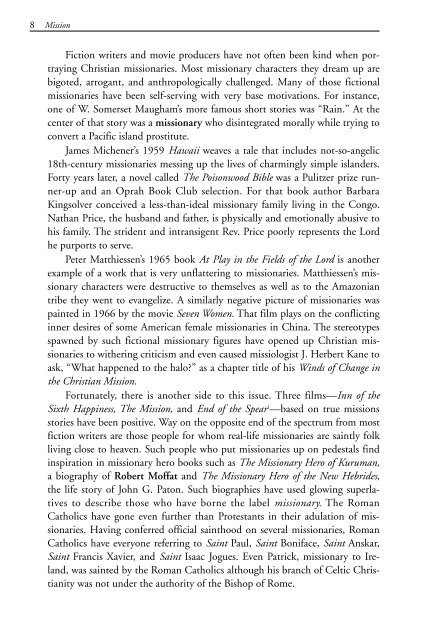discovering missions - Southern Nazarene University
discovering missions - Southern Nazarene University
discovering missions - Southern Nazarene University
Create successful ePaper yourself
Turn your PDF publications into a flip-book with our unique Google optimized e-Paper software.
245187 Disc Missions ins 9/6/07 1:04 PM Page 8<br />
8 Mission<br />
Fiction writers and movie producers have not often been kind when portraying<br />
Christian missionaries. Most missionary characters they dream up are<br />
bigoted, arrogant, and anthropologically challenged. Many of those fictional<br />
missionaries have been self-serving with very base motivations. For instance,<br />
one of W. Somerset Maugham’s more famous short stories was “Rain.” At the<br />
center of that story was a missionary who disintegrated morally while trying to<br />
convert a Pacific island prostitute.<br />
James Michener’s 1959 Hawaii weaves a tale that includes not-so-angelic<br />
18th-century missionaries messing up the lives of charmingly simple islanders.<br />
Forty years later, a novel called The Poisonwood Bible was a Pulitzer prize runner-up<br />
and an Oprah Book Club selection. For that book author Barbara<br />
Kingsolver conceived a less-than-ideal missionary family living in the Congo.<br />
Nathan Price, the husband and father, is physically and emotionally abusive to<br />
his family. The strident and intransigent Rev. Price poorly represents the Lord<br />
he purports to serve.<br />
Peter Matthiessen’s 1965 book At Play in the Fields of the Lord is another<br />
example of a work that is very unflattering to missionaries. Matthiessen’s missionary<br />
characters were destructive to themselves as well as to the Amazonian<br />
tribe they went to evangelize. A similarly negative picture of missionaries was<br />
painted in 1966 by the movie Seven Women. That film plays on the conflicting<br />
inner desires of some American female missionaries in China. The stereotypes<br />
spawned by such fictional missionary figures have opened up Christian missionaries<br />
to withering criticism and even caused missiologist J. Herbert Kane to<br />
ask, “What happened to the halo?” as a chapter title of his Winds of Change in<br />
the Christian Mission.<br />
Fortunately, there is another side to this issue. Three films—Inn of the<br />
Sixth Happiness, The Mission, and End of the Spear 1 —based on true <strong>missions</strong><br />
stories have been positive. Way on the opposite end of the spectrum from most<br />
fiction writers are those people for whom real-life missionaries are saintly folk<br />
living close to heaven. Such people who put missionaries up on pedestals find<br />
inspiration in missionary hero books such as The Missionary Hero of Kuruman,<br />
a biography of Robert Moffat and The Missionary Hero of the New Hebrides,<br />
the life story of John G. Paton. Such biographies have used glowing superlatives<br />
to describe those who have borne the label missionary. The Roman<br />
Catholics have gone even further than Protestants in their adulation of missionaries.<br />
Having conferred official sainthood on several missionaries, Roman<br />
Catholics have everyone referring to Saint Paul, Saint Boniface, Saint Anskar,<br />
Saint Francis Xavier, and Saint Isaac Jogues. Even Patrick, missionary to Ireland,<br />
was sainted by the Roman Catholics although his branch of Celtic Christianity<br />
was not under the authority of the Bishop of Rome.

















